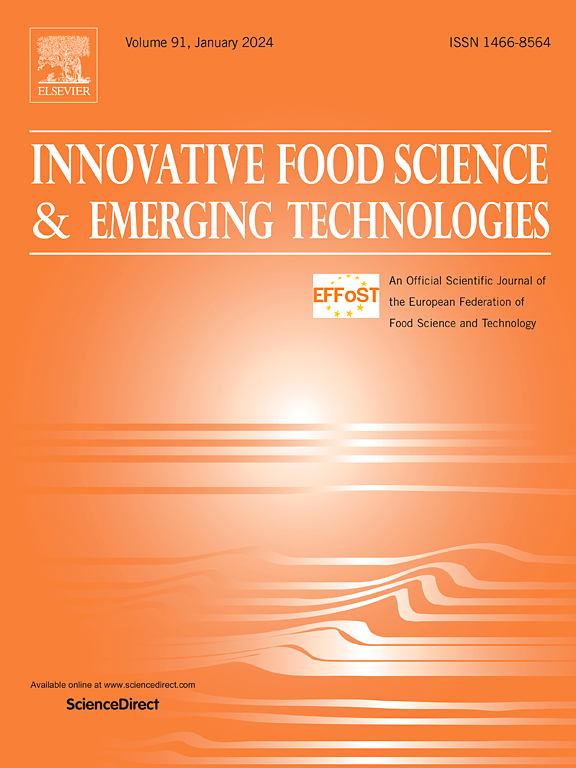脉冲电场与干燥方式对家蟋蟀微生物负荷及蛋白质特性的联合影响
IF 6.3
1区 农林科学
Q1 FOOD SCIENCE & TECHNOLOGY
Innovative Food Science & Emerging Technologies
Pub Date : 2025-04-20
DOI:10.1016/j.ifset.2025.104027
引用次数: 0
摘要
在世界上许多地方,蟋蟀已经被作为食物食用。脉冲电场(PEF)构成了一种非热食品加工工艺,能够提高微生物稳定性,增强传统工艺,改变蛋白质结构。本研究考察了PEF预处理(4.4 kV/cm, 500脉冲)对蟋蟀粉生产的影响,采用烘箱干燥和冷冻干燥。PEF在烘箱和冷冻干燥中分别降低了18.04%和49.82%的能耗。对生产的面粉进行了微生物学评价和蛋白质特性评价。虽然单独使用PEF不能完全灭活微生物,但与烘箱干燥相结合可以显著降低微生物水平(中温细菌、肠杆菌和霉菌的微生物水平分别为2.7 log/g、1.6 log/g和2 log/g)。没有注意到孢子数的减少。PEF对蛋白质特性的影响因干燥方式的不同而不同,冻干蟋蟀的二硫化物含量提高了34.18%,疏水性提高了39.94%,对氧化作用没有影响(烘箱粉和冻干粉的蛋白质含量分别为33.44和17.63 nmol/g)。胶体性能主要受干燥方法的影响。PEF还影响了烘干蟋蟀蛋白的二级结构。PEF预处理和干燥方法对蟋蟀粉的品质和稳定性有综合影响。本文章由计算机程序翻译,如有差异,请以英文原文为准。
Combined effect of pulsed electric fields and drying method on the microbial load and protein properties of house crickets (Acheta domesticus)
House crickets are already being consumed as food in many parts of the world. Pulsed electric fields (PEF) constitute a nonthermal food process capable of improving microbial stability, enhancing conventional processes, and altering protein structure. This study examined the impact of PEF pretreatment (4.4 kV/cm, 500 pulses) on cricket flour production, using oven-drying and freeze-drying. PEF reduced the energy consumption by 18.04 % in oven and 49.82 % in freeze-drying. Microbiological evaluation and assessment of protein properties were conducted on the produced flour. While PEF alone did not fully inactivate microorganisms, combining it with oven drying significantly reduced microbial levels (2.7 log/g, 1.6 log/g, and 2 log/g, for mesophilic bacteria, Enterobacteria, and molds, respectively). No reduction in spore count was noted. PEF influenced protein properties differently based on the drying method, increasing disulfide content by 34.18 % and hydrophobicity by 39.94 % in freeze-dried crickets and not influencing oxidation (33.44 and 17.63 nmol/g protein for oven and freeze-dried flours, respectively). Colloidal properties were primarily affected by the drying method. PEF also affected the secondary structure of oven-dried cricket proteins. PEF pretreatment and drying methods exhibit combined effect on the quality and stability of cricket flour.
求助全文
通过发布文献求助,成功后即可免费获取论文全文。
去求助
来源期刊
CiteScore
12.00
自引率
6.10%
发文量
259
审稿时长
25 days
期刊介绍:
Innovative Food Science and Emerging Technologies (IFSET) aims to provide the highest quality original contributions and few, mainly upon invitation, reviews on and highly innovative developments in food science and emerging food process technologies. The significance of the results either for the science community or for industrial R&D groups must be specified. Papers submitted must be of highest scientific quality and only those advancing current scientific knowledge and understanding or with technical relevance will be considered.

 求助内容:
求助内容: 应助结果提醒方式:
应助结果提醒方式:


